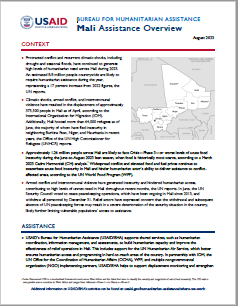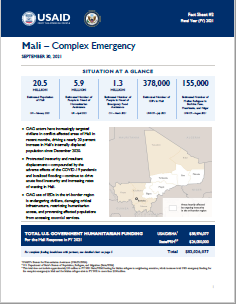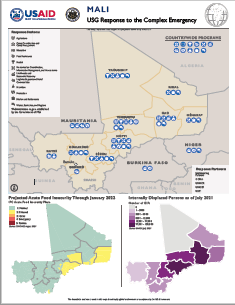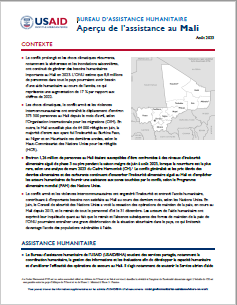Mali
With funding from USAID/OFDA, Near East Foundation (NEF) distributes cash vouchers to beneficiaries in Mopti Region, central Mali, in July 2013. Photo credit: NEF
Key Developments
Recurrent climatic shocks—including drought and seasonal floods—and protracted conflict continue to generate high levels of humanitarian need across Mali. An estimated 8.8 million people in the country are likely to require humanitarian assistance during 2023, representing a 17 percent increase from 2022 figures, the UN reports.
Organized armed group violence in the Liptako Gourma region—also referred to as the tri-border area, which encompasses the contiguous areas of northern Burkina Faso, southern and central Mali, and southwestern Niger—is endangering civilians, preventing affected populations from accessing essential services, restricting humanitarian access, and worsening food security conditions in Mali.
Background
Since 2012, conflict and climatic shocks—including drought and seasonal floods—have generated displacement, food insecurity, and widespread humanitarian needs throughout Mali. Approximately 412,000 people were displaced internally in Mali as of December 2022, according to the International Organization for Migration. Additionally, Mali hosted more than 63,000 refugees, the majority of whom fled insecurity in neighboring countries as of January, the Office of the UN High Commissioner for Refugees reports. Prolonged displacement, constrained humanitarian access, and disrupted livelihoods, continue to increase vulnerabilities among affected families, according to the UN.
On November 3, 2022, Chargé d'Affaires, a.i. Richard Nicholson reissued a declaration of humanitarian need due to the ongoing complex emergency in Mali. In response, USAID continues to support food-insecure and vulnerable internally displaced persons and host community members through projects that aimed to reactivate agricultural production, restore food security, and revitalize livelihood activities. In addition, USAID-supported programs aim to improve access to emergency health care, protection services, safe drinking water, and sanitation infrastructure.





